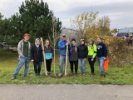Rail trail MUP studio wraps up
Northeast Greenway studio working in collaboration with UDCDA

Members of the Rail Trail studio and others participating in a UDCDA sponsored tree planting along the William L. Gaiter cycle track.
by Tyler Madell (MUP '20)
Published December 19, 2019 This content is archived.
Along with eleven other masters of urban planning students, I was part of an urban planning studio aimed at developing a vision for a new rail trail.
This one-mile trail, called the Northeast Greenway, would be a much needed link in Buffalo’s trail network connecting the existing North Buffalo and Tonawanda Rails to Trails with the off-road path that follows William L. Gatier Parkway.
Our guiding goals and objectives for this project include harnessing community connections both physically through design of trailheads and integration with existing transportation infrastructure. We also sought to promote a healthier neighborhood through active living and also a fully accessible trail for all types of potential users. In addition to promoting environmental health, we see the trail as a source of economic activation.
Planning studios are an opportunity for students to work collaboratively on solutions to real projects, through partnerships with the community. For this studio, we worked with Darren Cotton (MUP '10) and Stephanie Bucalo from the University District Community Development Association (UDCDA), a non-profit dedicated to community and housing development projects throughout South Campus’ backyard.
Building upon the successes of the North Buffalo Rails to Trails, which was brought to fruition through tireless community activism, the Northeast Greenway will continue the conversion of unused railroad corridors within Buffalo, creating a paved multi-use trail that is both a space for recreation and also a travel corridor for bicyclists and pedestrians.

The existing conditions and the proposed trail crossing at Main Street. A special on demand pedestrian signal known as a HAWK signal is proposed here.
To be practical, we put forth a number of different routing proposals to overcome various challenges along the route. These challenges included crossing Main Street, navigating around a section of the former rail right of way that has been turned into people’s backyards and a crossing over East Amherst Street. Our recommended route for the trail adheres to the route of the former rail right of way, calling for a new pedestrian crosswalk on Main Street and bridge to carry the trail over East Amherst Street. The trail will link together Shoshone, McCarthy and Kevin Roberson Parks.

Studio Instructor Ellen Parker, AICP working with students on route options.
All of us working on the studio had a diverse background and varying interests in planning, helping to create what we think is a very well rounded project proposal. Students specializing in urban design helped to create 3-D renderings of intersections and crosswalks in Sketchup. Environmental planning students developed innovative stormwater management measures along segments of the trail. For me, a bicyclist interested in transportation planning, I helped our group navigate design standards for bicycle and pedestrian infrastructure.
One of the special things about an urban planning studio at UB is the opportunity to develop new skills and essentially learn by doing. Many of us who were new to design software took a stab at developing renderings while those not too familiar with GIS software had the opportunity to create maps for their project section.
The process of compiling the report has left me feeling greatly inspired by the transformative nature of urban planning. It is up to us as planners to articulate the vision for our future communities, to shape plans that create people-oriented spaces while making sense given the community context. I hope other students will have the opportunity to work with the UDCDA and other community nonprofits through future urban planning studio experiences.
The process of compiling the report has left me feeling greatly inspired by the transformative nature of urban planning. It is up to us as planners to articulate the vision for our future communities, to shape plans that create people-oriented spaces while making sense given the community context. I hope other students will have the opportunity to work with the UDCDA and other community nonprofits through future urban planning studio experiences.
I believe I speak for our entire group in expressing our gratitude to Darren and Stephanie for their enthusiasm and vision for this project. Also we are thankful to Jim Jones, former town engineer of Tonawanda who helped us tremendously with this project. And lastly, thanks to our studio instructor Ellen Parker, AICP, for giving us the reins to truly take ownership over the direction of this project.









